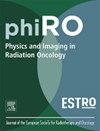Margins to compensate for respiratory-induced mismatches between lung tumor and fiducial marker positions using four-dimensional computed tomography
IF 3.4
Q2 ONCOLOGY
引用次数: 0
Abstract
Background and purpose
Tumors and fiducial markers do not always exhibit synchronous motion across different respiratory phases, in a phenomenon called the target localization error (TLE). We determined the margin to compensate for the TLE using four-dimensional computed tomography (4D-CT).
Materials and methods
We analyzed data from 21 lung tumor patients with fiducial markers; 11 for TLE determination and 10 for validation. Shifted CT images were generated by aligning the centroids of the fiducial markers in the reference phase of 4D-CT with those in each respiratory phase, and the union of gross tumor volumes (GTVs) was determined (). Conversely, variations in GTV centroids across the respiratory phases were calculated, and the 95th percentile of the root mean square error was defined as the TLE. Using this TLE, a GTV with an added TLE () was generated in the reference phase. Subsequently, a treatment plan assuming dynamic tumor tracking (DTT) was created for the planning target volume, derived by adding an isotropic 5 mm margin to , and the dose coverage for was evaluated.
Results
The TLEs (standard deviations of the root mean square error) were 2.0 (0.8) mm, 2.1(0.7) mm, and 3.2 (1.1) mm in the left − right, anterior − posterior, and superior − inferior directions, respectively. A dosimetric evaluation revealed that did not receive 100 % of the prescribed dose in four of 10 cases owing to artifacts.
Conclusion
The TLE can be compensated by adding an anisotropic margin to the GTV in the reference phase, a critical consideration in DTT.
利用四维计算机断层扫描补偿呼吸引起的肺肿瘤与基准标记物位置不匹配的边缘
背景和目的肿瘤和基准标记物在不同的呼吸期并不总是表现出同步运动,这是一种被称为目标定位误差(TLE)的现象。我们使用四维计算机断层扫描(4D-CT)确定了补偿TLE的裕度。材料与方法对21例肺肿瘤患者的基础标志物进行分析;11个用于TLE测定,10个用于验证。将4D-CT参考期基准标记物的质心与各呼吸期的质心对齐生成移位的CT图像,并确定总肿瘤体积(GTVunionshift)的并度。相反,计算呼吸期GTV质心的变化,并将均方根误差的第95个百分位数定义为TLE。使用这个TLE,在引用阶段生成一个带有附加TLE (GTVTLEref)的GTV。随后,根据计划靶体积建立假设动态肿瘤跟踪(DTT)的治疗方案,通过向gtunionshift添加各向同性5 mm的边界得到治疗方案,并评估gtunionshift的剂量覆盖范围。结果左-右、前-后、上-下三个方向的TLEs(标准差均方根误差)分别为2.0 (0.8)mm、2.1(0.7)mm和3.2 (1.1)mm。剂量学评估显示,由于伪影,GTVunionshift在10例中有4例未获得100%的规定剂量。结论参考相位GTV的各向异性裕度可以补偿TLE,这是DTT的一个重要考虑因素。
本文章由计算机程序翻译,如有差异,请以英文原文为准。
求助全文
约1分钟内获得全文
求助全文
来源期刊

Physics and Imaging in Radiation Oncology
Physics and Astronomy-Radiation
CiteScore
5.30
自引率
18.90%
发文量
93
审稿时长
6 weeks
 求助内容:
求助内容: 应助结果提醒方式:
应助结果提醒方式:


